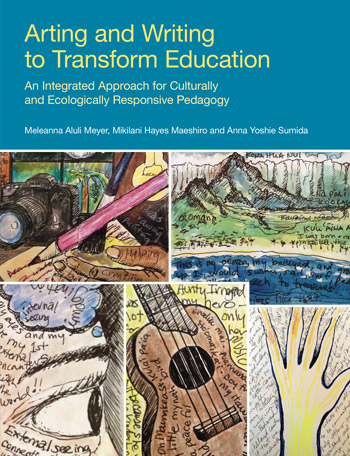Arting and Writing to Transform Education

ID: 1686 - View Book Page - Edit In OJS
This book introduces a theoretically motivated and classroom tested, culturally responsive approach to the education of children that teaches them how to see and describe their world – both the natural world around them and their own culture and identity – through linking the media of art and language, considered as parallel creative-expressive processes of arting (representation in visual images) and writing (representation in words). Developed in a collaboration by three Hawaii educators, the curriculum integrates knowledge and practices in literacy and culture, art and science, with a goal of creating a transformative educational experience for every child, building from the students’ home language and culture.
Starting from their own personal stories of what it is like growing up outside the cultural mainstream, in Part I the authors present the conceptual background to the work suggesting how the learning of bodies of knowledge and practical skills in school can be raised to a higher level of exploration and personalized learning that leads to a situated and empowered sense of self. Part II shows how arting and writing processes can work together and be mutually reinforcing to produce highly engaged learning, as demonstrated in the authors’ own elementary and middle school classes. Part III provides two extensive multi-lesson units, complete with objectives, lesson plans, and printable exercise sheets given in appendices. Hawaiian ecology and stories about the land offer illustrations of how teachers can integrate learning in students’ home language and culture with mainstream English language and culture. Further lesson material demonstrates how students can explore their own cultural identity as connected to family and place through arting and writing activities.
In his Foreword to the book, renowned New Zealand educator Sir Sidney Mead commends the authors for “bringing to the attention of a global audience the creative approach to classroom practice that they have set out in this book,” which is intended to instruct and engage learners at a high level of creativity and expression. In this way, the authors hope their approach embodies the highest form of education, that which “liberates human potential through transformational teaching and learning experiences.”
Arting and Writing to Transform Education is both inspirational and practical in content, suggesting an approach to educating children that will be enjoyable to teach and will engage learners in many ways and help them realize their full potential. It is also visually inspirational, richly illustrated in color with examples of student work and the work of artists and teachers, including that of the authors themselves, classroom photos showing children engrossed in their arting-writing projects, and other scenes of Hawaii.
Published: Nov 2, 2018
Series
Related Books
Reviews
I support the authors in bringing to the attention of a global audience the creative approach to classroom practice that they have set out in this book.
From the Foreword by Sir Sidney M. Mead
[The authors] are educators in the best sense of the word because they draw forth what is most vibrant and desirable in students/teachers/community – and that is the love of learning. This in turn creates the kind of meaning that transforms and teaches us to know ourselves. Here is the purpose of life, and the point of education that seems to have been misplaced with standardization, uniformity, and the commodification of knowledge.
From the Foreword by Dr. Manulani Aluli Meyer, University of Hawaiʻi